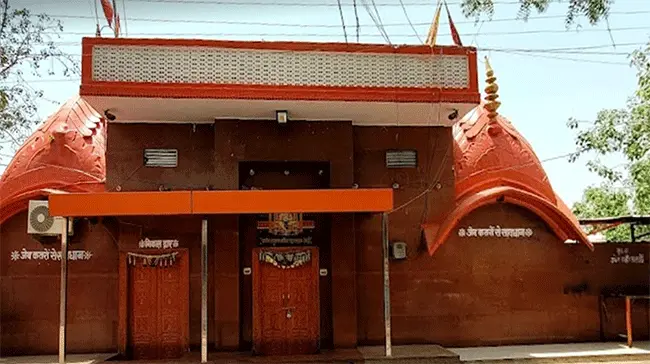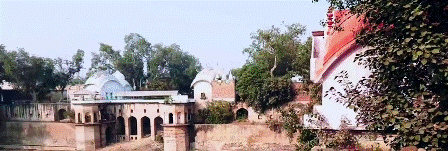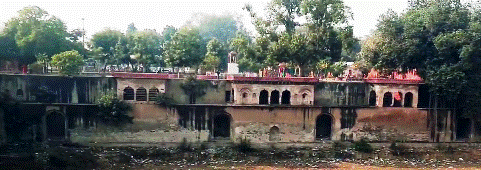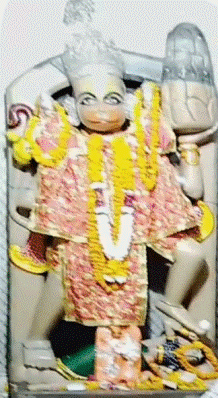
Rewari the Veer Bhumi
 One check at the historical background of the Rewari region from earlier days to till present will show why this is called ‘Veer-Bhumi’. Whether during the Mughal period or the China War of 1962, the bravery and patriotism shown by the persons from this region is commendable. During the medieval period and rule of Mughals in 1553-1556, Hemchandra Vikramaditya, nick-named as ‘Hemu’, of Rewari (whose initial occupation was selling saltpeter/gunpowder), became chief of the army and Prime Minister of Adil Shah who had become insane. In three years, Hemu fought 22 battles for Adil Shah, spanning the entire north India from Bengal to Punjab. He proved to be one of the greatest Hindu warriors in the history of India. Hemu played a crucial role in pre-Mughal history and was nearly successful in throwing Mughals out of India after victories over Akbar’s armies in Agra and Delhi. After centuries of foreign rule, Hemu re-established the Hindu Raj in North India on 6 October 1556 in a coronation in what is now known as Purana Quila, Delhi (Old Fort). In the 16th -18th century CE, Akbar made Rewari part of his empire after defeating Hemchandra in the 2nd battle of Panipat in 1556.
One check at the historical background of the Rewari region from earlier days to till present will show why this is called ‘Veer-Bhumi’. Whether during the Mughal period or the China War of 1962, the bravery and patriotism shown by the persons from this region is commendable. During the medieval period and rule of Mughals in 1553-1556, Hemchandra Vikramaditya, nick-named as ‘Hemu’, of Rewari (whose initial occupation was selling saltpeter/gunpowder), became chief of the army and Prime Minister of Adil Shah who had become insane. In three years, Hemu fought 22 battles for Adil Shah, spanning the entire north India from Bengal to Punjab. He proved to be one of the greatest Hindu warriors in the history of India. Hemu played a crucial role in pre-Mughal history and was nearly successful in throwing Mughals out of India after victories over Akbar’s armies in Agra and Delhi. After centuries of foreign rule, Hemu re-established the Hindu Raj in North India on 6 October 1556 in a coronation in what is now known as Purana Quila, Delhi (Old Fort). In the 16th -18th century CE, Akbar made Rewari part of his empire after defeating Hemchandra in the 2nd battle of Panipat in 1556.
In the action on 18 November 1962, 114 Indian soldiers out of a total of 120 were killed and more than 1000 Chinese troops were killed. A memorial in Rewari, where most of the Yaduvanshi soldiers came from, claims that 1,300 Chinese soldiers were killed in the battle. This battle was also important as China declared a ceasefire after watching the bravery of Indian soldiers in this battle. The contribution of Rewari cannot be ignored.
Name Rewari
The history of Rewari can be traced back to the Mahabharata period, and the legend has it that a king named Rewat had a daughter named Rewa after whom he founded a new city called ‘Rewa wadi’. When Rewa married Balram [warrior of his standing], the elder brother of Lord Krishna, the king donated the city ‘Rewa Wadi’ as a gift for her daughter. With time, the name Rewa Wadi became Rewari.
Rewari Now
After Mughals Rewari then came under Marathas. During their rule also Rewari was in the hem of affairs and played an important part role during the 1857 freedom struggle when Rao TulaRam was the ruler of Rewari. Then this place came under British rule. During Maratha’s and subsequent period welfare measures for the citizens, improving infrastructures, etc., were given priority. Even today many structures of those eras stand as witnesses for these activities. One such structure is today known as ‘Bada Talab’, which is an architectural beauty and engineering marvel.
Bada Talab
Since the city depends on the rain water the rulers had built lakes in line on the south of present Bada Talab. Once the first lake is filled water will overflow to the second and when that also is filled, the overflow water will reach Bada Talab. Bada Talab has been designed to store huge quantities of water with strong walls around it. In case if this tank is also full, the overflow water will reach the other lake.
 The tank is more or less square and maybe around fifty feet deep. The tank has separate bathing Ghats for men and women. Cattle to drink water from the tank ramp have been provided. The arches around the tank, the entrances to the Ghats, and the structures around the tank are all architecturally great. A lot of effort had been put into planning this tank.
The tank is more or less square and maybe around fifty feet deep. The tank has separate bathing Ghats for men and women. Cattle to drink water from the tank ramp have been provided. The arches around the tank, the entrances to the Ghats, and the structures around the tank are all architecturally great. A lot of effort had been put into planning this tank.
There are three temples around the tank. The first one on Brahm Ghat is a temple for Lord Shiva, the water inlet for this tank is from this side. Just opposite to this Ghat is Gow Ghat from where cows can enter for drinking water for which ramps had been provided. On this front, there is the temple for Maa Parvati. There is a temple for Lord Hanuman on the eastern side opposite Janana Ghat which is on the western side of the tank.
It is said that the Shiv mandir came first and then the tank was constructed. The other temples were later additions. Nevertheless, the new temples were also constructed in alignment with the architecture of the earlier construction.
Builder of this tank
According to the website of Govt., of Haryana, the Bada Talab in Rewari was built by Rao Tej Singh during the year 1810-1815 so it is also known as Rao Tej Singh Talab. But the inscription slab put up by the Municipal committee at this Talab site says the work was completed in 1776.
There are three temples around the tank. The first one on Brahm Ghat is a temple for Lord Shiva, the water inlet for this tank is from this side. Just opposite to this Ghat is Gow Ghat from where cows can enter for drinking water for which ramps had been provided. On this front, there is the temple for Maa Parvati. There is a temple for Lord Hanuman on the eastern side opposite Janana Ghat which is on the western side of the tank.
Hanuman Mandir
As stated this mandir is located on the eastern side of the talab. The temple had been recently renovated with marble, vitrified tiles, and granite slabs laid and modern look. It has the Garbhagrah facing north. Devotees can have Darshan of the Lord from the huge hall itself. There are two towers [vimanam] for the mandir and on the southern side is the Garbhagrah. Today the mandir is distinctly from all sides since painted in saffron color. [In Google Maps place had been wrongly marked, look for saffron color building nearby for the actual mandir.]
Legend of the Mandir
 Some two hundred years ago a merchant was taking the moorthi of Sri Hanuman from Rajasthan and on the way he halted at this place. After a day or two when he started to move towards his destination, he could not move the cart where Sri Hanuman's idol was kept. He was wonder-struck as to what had happened to the cart since it had travelled smoothly from Rajasthan till now. On consultation with elders and learned people of the town it was opined that it seems that the Lord wants to stay at the very same place. Thereafter the trader decided to leave the idol at that place itself and moved towards his destination.
Some two hundred years ago a merchant was taking the moorthi of Sri Hanuman from Rajasthan and on the way he halted at this place. After a day or two when he started to move towards his destination, he could not move the cart where Sri Hanuman's idol was kept. He was wonder-struck as to what had happened to the cart since it had travelled smoothly from Rajasthan till now. On consultation with elders and learned people of the town it was opined that it seems that the Lord wants to stay at the very same place. Thereafter the trader decided to leave the idol at that place itself and moved towards his destination.
Residents of Rewari thereupon built a temple for Lord Sri Hanuman. The temple building was designed on the same lines as the other buildings around the Talab as stated earlier. Apart from the idol brought from Rajasthan, there is a small idol of Sri Hanuman placed on the ground with vermillion smeared. Devotees offer vermillion as manath to the Lord.
Sri Hanuman –Bada Talab
Lord is seen in a standing position trapping a demon below His left lotus foot. Lord's right foot is firm on the ground. Lord is wearing a loincloth. His tail is raised with a small bend in the end seen near His right shoulder. Lord is seen with ‘Sanjeeviji parvat’ in His left hand. His right hand is seen resting on the hip. In both His hands he is wearing kankanam [in the wrist] and angat [in the upper arm]. Lord is seen carrying Sri Rama and Sri Lakshmana on His shoulders.
A decorative tape is holding His hair in tack. Over that, He is wearing a crown. In ears, He is wearing a kundal and also a decorative ornament on the top of the ear. Bright face with smiling eyes and lips is bound to hold the attention of the devotee captive by Him. The very first Darshan the Lord itself the devotee is sure to realise the blessing Baba is giving.
Location of the temple: "Bada Talab Sri Hanuman Mandir, Rewari"
Experience
Visit the temple on a working day sit quietly in the pragan facing the Lord keep your eyes open and meditate upon Him. Feel what heaven is.
SRI HANUMAN THINKS DIFFERENTLY, THINKS FAST
THINKS AHEAD AND ACTS FOR SURE
Ed [Oct 2022]
Updates: [15.10.2022, Jan 2025]
